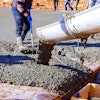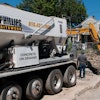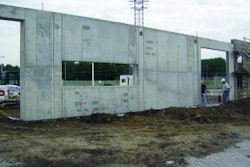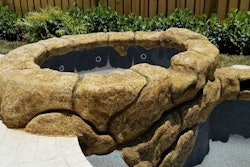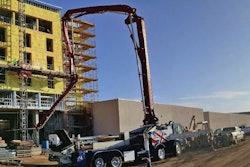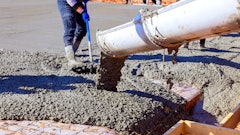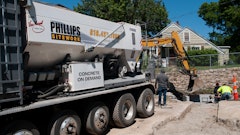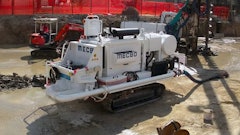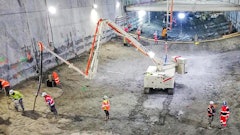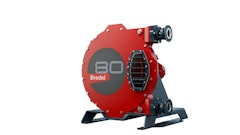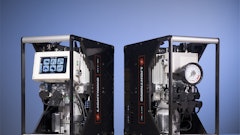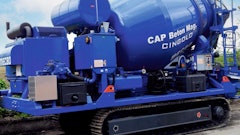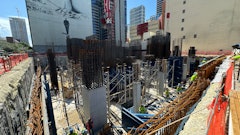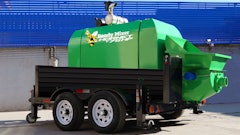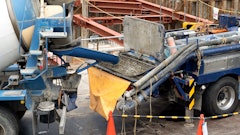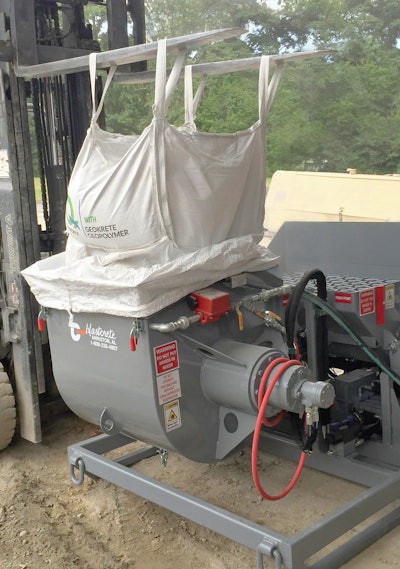
The costs of adhering to new and changing safety regulations, maintaining up-to-date protective equipment and covering employee injuries is increasingly burdensome for many companies. This isn’t to say that injury prevention is not extremely important, but instead that many businesses are taking the wrong, and often more expensive, approach.
Employees in construction and refractory can be exposed to safety hazards and long-term health risks at their jobsites. The cost of protecting employees — especially those new to the industry — in potentially hazardous situations can add up quickly. Shotcrete and gunite work is no exception. A recent initiative, Prevention through Design, is working to reduce injuries, improve worker safety and lower long-term costs before machinery ever hits the market.
Understanding PtD
Prevention through Design, or PtD, considers all hazards that could put workers at risk, including carelessness, distractions and inexperience. Those considerations take place before the equipment is built, and then the safety features are tested before the product ever goes to market. When applied properly, PtD results in substantial savings for contractors through lower employee turnover and fewer injuries.
Manufacturers implementing PtD do so by emphasizing worker safety throughout the entire design and manufacturing process for new and updated equipment. Engineers, managers and assembly workers are all encouraged to speak up if they spot a potential safety hazard.
With high-pressure shotcrete and gunite machinery, fast-moving materials, powerful pumps and hydraulic systems present potential hazards on a daily basis while, at the same time, noise, heavy lifting and air contaminants can result in long-term health problems if not properly addressed in the design stages.
While safety regulations are in place to protect workers and provide standards with which manufacturers must comply, manufacturers choosing to embrace PtD go above and beyond industry standards. In many cases, this prevents injuries and adverse long-term health complications. Rather than relying on personal protective equipment to bridge gaps between equipment functionality and safety regulations, some manufacturers take things a step further, factoring in functionality, operating expenses and customer preferences to design safe, user-friendly equipment. At times this even involves engineers working hands-on with equipment at jobsites, gaining end-user perspectives that can help advance product designs.
Fewer injuries, and in many cases the elimination of high-priced PPE, can add up to huge savings over the life of a new machine — leading more and more companies to take a close look at manufacturers that implement PtD.
PtD for Pumps
Powerful pumps are paramount for moving high-viscosity shotcrete materials. High-quality, well-built machines will accomplish that task, but not all machines are designed with safety being considered just as important as productivity.
Some contractors still use ball valve pumps, which are not reversible. When a hose or line becomes plugged, it can be difficult to release pressure from the material conveying system. The absence of clear safety protocols can result in unexpected and dangerous high-pressure releases and even explosive material occurring at connections in the conveying system or pump discharge. The increased possibility of injury to field personnel compromises their well-being and creates additional risks and exposure for all involved. Accidents will also impact production on the site, increasing costs. For this reason, choose equipment with reversible squeeze tube or piston pumps. These options prevent hazardous situations and reduce equipment downtime if a line does become plugged.
PtD for Dust
As OSHA’s air contaminant and silica dust regulations become more and more restrictive, many contractors are forced to rely on expensive protective gear to be in compliance. Large contractors are dealing with how quickly these additional costs are adding up. For example, full-face respirators typically cost as much as $500. For a contractor required to provide respirators for 100 employees, the cost can easily exceed $50,000. The price tag shoots up dramatically with new regulations that will require these same employees to switch from full-face respirators to enclosed head gear, which can cost as much as $2,500 — quintupling the cost.
Many of these expenses may be avoided with equipment designed to dramatically reduce air impurities. Before new regulations take effect, manufacturers embracing PtD have been working diligently to develop solutions to protect individuals working with industrial mixer-pumps, taking the onus off employers. Contaminants enter the air when workers dump 50-pound bags of material into the mixer. This billowing dust can easily be eliminated with the use of specially designed 500-pound bulk bags. By adding a dust shroud to traditional bulk bags, the material can be moved into place with a forklift — and a quick tightening of the shroud around the hopper opening will create a seal that prevents the dust from escaping as the bottom of the bag slices open over the machine.
When the dust settles, this design and practice may reduce the need for expensive breathing apparatuses, but also prevents injuries and strains that result from repeatedly lifting 50-pound bags — 10 of which would be needed to equal a single bulk bag.
PtD for Hopper Systems
Prevention through Design is achieved in a number of ways. One approach includes working with equipment in the field to help develop a better understanding of day-to-day equipment operations. Manufacturers that embrace this approach are more likely to stumble upon simple solutions to problems they didn’t know existed, such as routine maintenance being skipped because of poor accessibility.
For example, the pump, lower valve box and other systems should be inspected and serviced before each job to ensure everything is in top working condition. Skipping this step can lead to equipment failure and costly downtime.
PtD has led one manufacturer to design a hopper system that swings out of the way, providing safe and hassle-free access to the lower valve box, wash box, sensor locations, flat pack and pump system. This hopper design eliminates the need for technicians to strain and contort themselves into uncomfortable positions between the hopper, frame and hydraulic lines to complete routine maintenance.
In addition to improved access, the design eliminates pinch points, reduces the risk of cuts and sprains, and minimizes opportunities for workers to hit their heads. Configuring equipment with ease-of-access in mind also reduces the likelihood of important maintenance steps being skipped all together.
PtD Considers All the ‘Little Things’
Prevention through Design also leads manufacturers to make minor alterations to designs that, collectively, result in equipment that is both safer and more user-friendly.
While automatic shut-off switches on pumps are now a standard safety feature, they become ineffective when aging switches begin to malfunction or when material buildup interferes with proper operation. Malfunctioning switches force operators to manually reset and restart the mixer-pump. In some cases, operators simply bypass the old contact switches altogether, eliminating any safety benefits. Some manufacturers have addressed this problem by using non-contact limit switches. These switches, even with material buildup, stop and start everything with the opening and closing of the grating.
Another regulation that equipment manufacturers can make less burdensome for contractors is noise. By designing equipment that is compliant with noise regulations for 8-hour shifts, workers are able to limit their use of noise-reducing headgear. That PtD feature prevents hearing loss claims from employees who don’t follow proper PPE standards.
PtD extends beyond the equipment, too. Many third-party trailers aren’t designed specifically for mixing and pumping applications and the corresponding safety considerations. Some shotcrete and gunite machine manufacturers produce their own trailers as a means of cutting manufacturing costs, while others design and produce their own to ensure each trailer is perfectly suited for its pump. The latter provides an opportunity to include reinforcements wherever necessary, reducing the likelihood of the trailer not being sufficiently sturdy. Manufacturers choosing this route are also more likely to choose heavy-duty steel, use durable welds and incorporate a sturdy axle that is properly aligned and balanced. Contractors need equipment that can be safely and conveniently transported at highway speeds, and having a well-constructed trailer with an axle rated for highway use reduces the odds of a dangerous incident.
A well-built machine also will have minimal sharp edges, rough surfaces, pinch points and potential fall hazards to reduce the risk of cuts, abrasions, burns and head injuries. When it comes to sawing, welding and fabricating equipment parts, a little extra attention on the manufacturer’s part can eliminate sharp, abrasive edges and surfaces. Designs should also take into account worker heights to minimize strain; not all workers are 5-foot-10 inches, and machines shouldn’t be designed as if they are.
Machines with adequate platforms and wide walkways provide room for workers to move freely, and in some cases, have space for multiple people. High-quality diamond plate grating, sturdy ladders and ample railings can also go a long way toward enhancing safety. When equipment is being manufactured, many of these factors can be overlooked or simply ignored to keep the process moving forward without causing delays and adding costs. Not with PtD.
Reducing hazards through smart designs is one of the most effective solutions for preventing injuries, reducing the need for protective gear and staying one — if not two or three — steps ahead of regulatory standards. Cautions, warnings, yellow paint and protective equipment are standard with most industrial equipment, however designing out hazards is becoming an equally popular — and more effective — method for reducing the risk of injury. Over time, this makes equipment less expensive to own and operate.
Ultimately, it’s tough to argue with equipment that’s designed to protect workers by preventing safety hazards. Saving money is just an added bonus.
Ed. Note: Bill Allen, sales manager for Blastcrete Equipment Company, helps customers around the world automate processes with Blastcrete equipment. He has more than 30 years of experience in construction and refractory. He studied business at the University of North Texas, and he is an ICRI-certified Concrete Slab Moisture Technician. He was previously an ACI-certified Concrete Field Testing Technician and Aggregate Testing Technician. He is also an associate member of ACI Committee 302 for construction of concrete slabs and Committee C660 for Shotcrete Nozzleman Certification. Allen also sits on the ASTM Committee C09 for concrete and aggregates and Committee F06 for resilient flooring. He can be reached at [email protected] or 800-235-4867.


